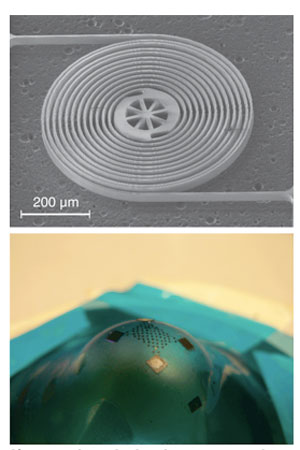Nanostructures, stretchable silicon, plasmonics and photonic crystals are just some of the solar topics explored in Peter Peumans lab.
Professor Peter Peumans of Stanford University spoke on Wednesday evening at the SVPVS (Silicon Valley Photovoltaic Society) on approaches to lowering the cost of solar energy conversion.
Peumans is an Assistant Professor of Electrical Engineering at Stanford and Deputy Director of the Center for Advanced Molecular Photovoltaics (CAMP). He is an expert in solar cell modeling and characterization and has developed several organic solar cell device architectures.
The professor has great intentions and is motivated by what he sees as clear evidence of anthropogenic global warming. He cited the beautiful statistical graphics of Hans Rosling and the direct relations of energy usage and quality of life, the evidence of global warming in E.J. Brook's "Tiny Bubbles Tell All", and the book Sustainable Energy without the Hot Air.
Peumans concluded, "We have the moral imperative to come up with a fuel source that is clean and low cost," and that is why he and his students, "look at crazy ideas," in order to substantially lower the cost of solar energy.
Some of his solar research projects explore:
- Molecular photovoltaics
- Nanostructured materials
- Stretchable silicon -- silicon plus MEMS
- Organic materials -- cheaply synthesized molecules
- Plasmonics
- Optical coatings for solar thermal applications
- Managing light in thin absorbers
- Photonic crystals
- Optical antennas -- metal nanostructures as optical antennas
- Low cost thin film transparent conductors
- Solar cells where every layer is solution processed
One of his research areas has drawn funding from venture investors. Peumans is the co-founder and Chief Scientific Advisor of NetCrystal, a startup using the stretchable silicon developed by Peumans’ group at Stanford. Bala Padmakumar is the CEO of NetCrystal, which is funded by Wellington Partners, Siemens, and X-Seed.
NetCrystal's MEMS-style solar technology lets photovoltaic silicon stretch and expand to cover large areas. THe CEO has claimed that the device's efficiency will rival and exceed that of the mighty SunPower (~20%) while beating the price claims of the thin-film start-up Nanosolar ($.99/watt).
Interconnected nodes of PV silicon surrounded by coiled silicon are fabricated in a relatively standard DRIE process upon a flexible polymer substrate. The substrate is then mechanically stretched to expand many times resulting in distributed PV "islands" which are already connected by the now uncoiled silicon - ostensibly eliminating the wafer to wafer interconnection now performed on panels using wafered silicon. The spaced silicon islands are assembled in an 8X micro-concentrator arrangement using compression-molded non-imaging, non-tracking optics.
According to an SBIR document: "The stretchable silicon process can achieve accurate placement and electrical wiring of thousands of miniature solar cells in one parallel and potentially low-cost step."
Peumans claims that the finished product is "potentially 20% efficient at $0.50 to $0.70 per Watt" He concluded his talk on this beautiful but dubiously commercializable science with a rousing "We have not seen anything yet that shows it won't work," and "I'd like to think it's going to work."
Source : Greentech Media, 15/01/10
Aucun commentaire:
Enregistrer un commentaire